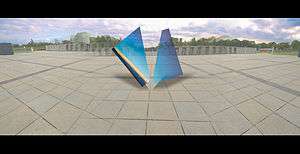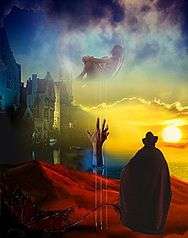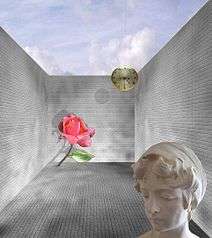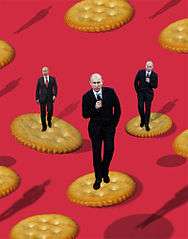Massurrealism

Massurrealism is a portmanteau word coined in 1992 by American artist James Seehafer,[1] who described a trend among some postmodern artists that mix the aesthetic styles and themes of surrealism and mass media—including pop art.[1]
History

Massurrealism is a development of surrealism that emphasizes the effect of technology and mass media on contemporary surrealist imagery.[1] James Seehafer who is credited with coining the term in 1992[1] said that he was prompted to do so because there was no extant definition to accurately characterize the type of work he was doing, which combined elements of surrealism and mass media, the latter consisting of technology and pop art—"a form of technology art."[2] He had begun his work by using a shopping cart, which "represented American mass-consumerism that fuels mass-media", and then incorporated collages of colour photocopies and spray paint with the artist's traditional medium of oil paint.[2]
In 1995, he assembled a small group show near New York City and found a local cyber-cafe, where he started to post material about massurrealism on internet arts news groups, inspiring some German art students to stage a massurrealist show.[2] The next year he started his own web site, www.massurrealism.com and began to receive work from other artists, both mixed media and digitally-generated.[2] He credits the World Wide Web with a major role in communicating massurrealism,[2] which spread interest from artists in Los Angeles, Mexico and then Europe.[3]
Seehafer has said:
| “ | I am not being credited with inventing a new technique, nor I don't think I should be credited with starting a new art movement, but rather simply coining a word to categorize the type of modern day surrealist art that had been lacking in definition. As a result, word "massurrealism" has received a lot of enthusiasm from artists. Though there are some who feel that defining something essentially limits it, the human condition has always had the need to categorize and classify everything in life.[2] | ” |
The differentiating factor, according to Seehafer, between surrealism and massurrealism is the foundation of the former in the early 20th century in Europe before the spread of electronic mass media.[2] It is difficult to define the visual style of massurrealism, though a general characteristic is the use of modern technology to fuse surrealism's traditional access to the unconscious with pop art's ironic contradictions.[3]
In 2005, graffiti artist Banksy illicitly hung a rock in the British Museum showing a caveman pushing a shopping cart, which Shelley Esaak of about.com described as "a nice tribute to James Seehafer and Massurrealism."[4]
Artists
Ginnie Gardiner, Cecil Touchon,(sound collage & poetry) F. Michael Morris and Alan King[5] are massurrealist artists.
German artist Melanie Marie Kreuzhof, who describes her work as massurrealistic, was commissioned in 2004 by the editor of the Spectakel Salzburger Festsiele Inside magazine to produce an artwork about Erich Wolfgang Korngold's opera Die tote Stadt at the Salzburg Festival.[6] To make her work she took 9 digital photographs, composed them in a computer and printed the result directly onto canvas, which was then attached to a wooden frame, worked on with acrylic paint and had objects attached—3 guitar strings, a strand of hair and a silk scarf.[6] The images and elements were derived from themes in the opera.[6] British artist Alan King started to experiment with a combination of digital and traditional art methods in the 1990s, producing a majority of his works by using computer techniques combined with a multitude of traditional methods including oils, acrylic, and watercolor.[7] Nationally renowned photographer Chip Simons incorporates both his photo images with digital collage. [8]



Notes and references
- 1 2 3 4 Adam. "massurrealism", Intute:arts and humanities (University of Oxford and Manchester Metropolitan University), 17 October 2003. Retrieved 8 March 2008.
- 1 2 3 4 5 6 7 Seehafer, James. "Discussions: The Artist and Modern Society.", lecture on Massurrealism at Saint Petersburg State University, Saint Petersburg Russia, 20 June 2000. Retrieved 8 March 2008.
- 1 2 "Other art", ebay.com. Retrieved 8 March 2008.
- ↑ Esaak, Shelley. "Banksymus Maximus", about.com, 22 May 2005. Retrieved 8 March 2008.
- ↑ Massurrealism: A Dossier (a.k.a. Massurrealismus: Ein Dossier). Novus Haus. ISBN 0-9759923-0-9.
- 1 2 3 Dixon, Troy. "'Die tote Stadt', 2004", korngold-society.org. Retrieved 8 March 2008.
- ↑ Cover Impressions Cover artist bio article - overview of Alan King & massurrealism - April 2010 (printed edition – Virginia, USA) .
- ↑ The Photo Imaging Information Council Overview of photo techniques of Chip Simons.
Further reading
- Seehafer, James / Morris, Michael / Kocsis, Phillip (2013). Three Essays About Massurrealism. Princeton: University Plaza Press. ISBN 9780991246106.
- Lantzen, Sean (2004). Massurrealism: A Dossier (a.k.a. Massurrealismus: Ein Dossier). Zurich: Novus Haus. ISBN 0-9759923-0-9.
- Staff writer (19 May 2005). "Cave art hoax hits British Museum". BBC News. Retrieved 14 April 2011.
- University Of New England, TURING ARTS SYMPOSIUM 2012 with the AISB/IACAP WORLD CONGRESS - discussion and visualizations of man/machine similarities and differences in select art works of surrealism e.g. Matta 1938 and Massurrealism of the 21st century.
- "The Inevitability Of Massurrealism" - Mark Daniel Cohen Wegway No:7 page 52 (Printed edition - Toronto Canada) November, 2004.
- "Avant Garde Under Net Conditions" - Perspektive (Printed edition - Austria) June 2002, and online. German text only.
- "What is new In The Surreal World" - Art and Antiques Magazine, (USA) March 2006.
- Celia Fernández, Contemplando el Massurrealismo Contemplating Massurrealism, Instituto Superior de Danza Alicia Alonso de La Universidad Rey Juan Carlos, Mardrid, Spain - text in both Spanish and English
- "Massurrealism Yields New Unique Vision" - Computer Artist (USA) August/September 1996.
- Brunner, Dr. Cornelia & Tally, William (1999). The new media literacy handbook. Anchor Books ISBN 978-0-385-49614-8.
- Hoffman, Barry Howard (2002). The fine art of advertising: irreverent, irrepressible, irresistibly, ironic. Stewart, Tabori & Chang. Original from the University of Michigan
- Touchon, Cecil (2007). Happy Shopping - Massurrealist Spam Poetry. Fort Worth: Ontological Museum Publications. ISBN 0-615-18244-5.
- King, Alan (2009). A Room Of Illusions - the Massurreal & Illusionary art of Alan King. Fort Worth: Ontological Museum Publications. ASIN: 0615263054
External links
- "What Is Massurrealism?" on YouTube - brief overview of the influences and origins (Art Media Journal)
- Three Essays About Massurrealism audiobook version released in 2013. Narrated by Grover Gardner, 35 minutes
- The Museum For Massurrealist Art homepage